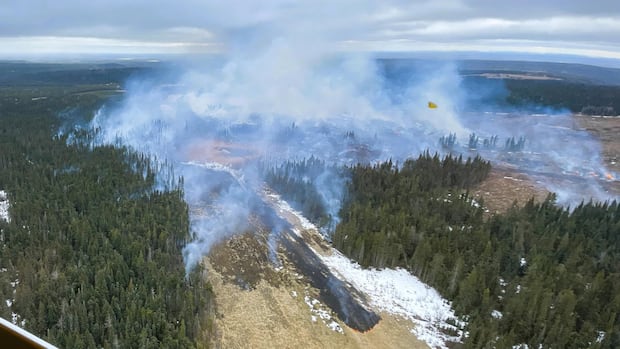A pipeline rupture that sparked a 2024 wildfire in west-central Alberta was caused by a crack, says a report released Thursday.
The Transportation Safety Board of Canada (TSB) published its findings on the causes of the rupture of a natural gas pipeline near Edson, Alta., which is located about 200 kilometres west of Edmonton.
The report says that at approximately 10:45 a.m. on April 16, 2024, a 36-inch pipeline transporting sweet natural gas ruptured around 36 kilometres northwest of Edson. It notes the pipeline was owned by Nova Gas Transmission Ltd., a subsidiary of TC Energy Corp.
An investigation determined that the pipeline rupture was caused by stress corrosion cracking resulting from a combination of soil conditions, the pipeline’s degraded protective coating and increased internal pressure.
The report says soil testing at the location showed microbiological activity with the potential to corrode the pipeline’s steel, and that the pipe’s compromised external coating left its steel exposed to the external environment where corrosion could occur.
The report says on the morning of the explosion, the pipeline’s pressure was increased to the highest operating level that the incident location had ever experienced, resulting in the crack fully rupturing.
In a news release, the TSB said “the crack that led to the pipeline rupture was detected by a 2022 in-line inspection but was classified as non-reportable” by analysts.
The report says a potential crack identified at the location of the rupture was downgraded to a non-reportable “metal loss” feature classification by a team of analysts with the inspection service provider Baker Hughes.
As a result of the downgraded classification, the TSB report says the crack was not included in TC Energy’s inspection analysis process or risk assessment for the pipeline.
“The variability of human performance introduces the possibility that a pipeline crack may not be identified, resulting in a missed opportunity to manage it,” the TSB said in a news release.
In a statement, TC Energy said it takes the findings from the TSB report seriously and is committed to working closely with its in-line inspection vendors to strengthen their process and improve integrity management practices.
It said it is committed to learning from this incident and enhancing the integrity and safety of its pipeline system.
Baker Hughes did not immediately respond to CBC’s request for comment.
The report also includes new details about the aftermath of the rupture, and the ensuing wildfire.
It says following the rupture, the natural gas ignited, which resulted in an explosion that created a seven-metre-deep crater.
The investigation noted that about 20 metres of the pipe was ejected due to the explosion, and the largest piece of debris was launched 200 metres away from the location of the rupture.
The escaping natural gas from the rupture ignited and burned until the fire self-extinguished at 1:45 p.m. that day. The report says almost six million cubic metres of natural gas was released due to the rupture.
The report says the incident then caused a wildfire that burned just over 60 hectares, but no injuries were reported.
The ruptured section of the pipeline was replaced and then returned to service under a reduced operation pressure on May 27, 2024.







